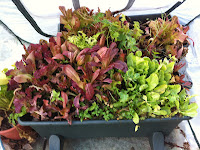Saturday, August 25, 2012
 |
| Cool season greens |
August is prime time for getting the seeds and plants in for fall and winter gardening. You can grow everything in fall as you did for spring. Think fresh, crisp lettuce, broccoli, cabbage, peas, carrots, spinach, leeks, cauliflower, turnips, onions, cilantro, radish, tat-soi, fava beans, escarole, frisee, fennel, parsley, mustard, kale.
For the courageous, you can also try bush beans or cucumbers. There are varieties that mature in 50 days. Those you better get in quick though to be able to harvest much before frost moves in.
One thing to keep in mind is how long you want to be able to harvest from your garden. The change I make from spring to fall plantings is in the spring, I plant those varieties that are heat tolerant. In the fall, I plant those varieties that are cold tolerant to extend the harvest as long as possible into winter. Depending on the severity of the winter, many cold tolerant varieties revive in the spring and provide a really early, nice harvest surprise.
In order to know when to plant, take the harvest time on the package, add 2 weeks to it, and back up from your first frost date. You add a couple of weeks because in the cool weather and shortening days, plants don’t grow as fast. You also want a little buffer in case frost comes early.
You can wait a little longer before planting if you buy bedding plants. These are hard to come by in most areas, but as more people are gardening, it is worth a phone call to see. In snooping around on internet seed companies, Burpee’s did have some fall bedding plants for sale (cabbage, kale, cauliflower and broccoli).
I like to do seeds in my Earthboxes as a pot is easy for me to keep moist for the seeds to sprout. They have a built in water reservoir. After the seedlings come up and have some good growth, I will transplant elsewhere.
Just like in spring, seeds have to be kept moist to sprout. You can also plant the seeds in peat pots or you can reuse the plastic annual trays you got in the spring. You can put the plastic trays in a water catch pan, find a shady spot convenient to watering, fill with seed starting mix, sow your seeds and keep moist. When the seedlings get their true leaves on them (second set), they are ready to transplant into the garden or a larger pot.
Lettuce varieties that have performed well into winter for us here in Zone 6: North Pole butterhead, Rouge d’Hiver romaine (pretty red and green), Winter Density romaine, Winterwunder loose leaf (pale green), Marvel of the Four Seasons butterhead (green with cranberry tips). I will also plant Prizeleaf, green and red Royal Oak leaf, Red Salad Bowl, and Ashley mix loose leaf varieties as all of these came back as volunteers in the spring.
We have used a portable plastic green house that is about 3’ wide, high and deep for the last couple of years. I have tried them over a garden bed and over our Earthbox pots. Both worked well and have had celery, lettuce, chard and mustard all through winter.
Fall is also a great time to plant perennial greens and vegetables. They are typically the first up in the spring. Things like salad burnet, French sorrel, arugula, radicchio, chives, chard, fennel, rhubarb, asparagus, French dandelion.
Late fall is also garlic planting season. Make sure you get the garlic ordered you want as many are sold out early. I ordered Turkish Giant garlic this year. I am all about maximizing the amount of food I get per square foot. I will add this one to my Elephant garlic plantings.


No comments:
Post a Comment